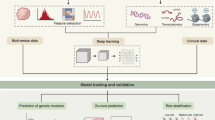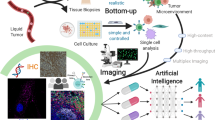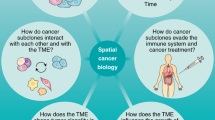Abstract
Paralleling the diversity of genetic and protein activities, pathologic human tissues also exhibit diverse radiographic features. Here we show that dynamic imaging traits in non-invasive computed tomography (CT) systematically correlate with the global gene expression programs of primary human liver cancer. Combinations of twenty-eight imaging traits can reconstruct 78% of the global gene expression profiles, revealing cell proliferation, liver synthetic function, and patient prognosis. Thus, genomic activity of human liver cancers can be decoded by noninvasive imaging, thereby enabling noninvasive, serial and frequent molecular profiling for personalized medicine.
This is a preview of subscription content, access via your institution
Access options
Subscribe to this journal
Receive 12 print issues and online access
$209.00 per year
only $17.42 per issue
Buy this article
- Purchase on Springer Link
- Instant access to full article PDF
Prices may be subject to local taxes which are calculated during checkout




Similar content being viewed by others
References
Eisenberg, R.L . Radiology: An Illustrated History (Mosby Year Book, St. Louis, 1991).
Chung, C.H., Bernard, P.S. & Perou, C.M. Molecular portraits and the family tree of cancer. Nat. Genet. 32 Suppl, 533–540 (2002).
Segal, E., Friedman, N., Kaminski, N., Regev, A. & Koller, D. From signatures to models: understanding cancer using microarrays. Nat. Genet. 37 Suppl, S38–S45 (2005).
Chen, X. et al. Gene expression patterns in human liver cancers. Mol. Biol. Cell 13, 1929–1939 (2002).
Nino-Murcia, M. et al. Focal liver lesions: pattern-based classification scheme for enhancement at arterial phase CT. Radiology 215, 746–751 (2000).
Segal, E. et al. Module networks: identifying regulatory modules and their condition-specific regulators from gene expression data. Nat. Genet. 34, 166–176 (2003).
Ashburner, M. et al. Gene ontology: tool for the unification of biology. The Gene Ontology Consortium. Nat. Genet. 25, 25–29 (2000).
Kerr, D.J. Targeting angiogenesis in cancer: clinical development of bevacizumab. Nat. Clin. Pract. Oncol. 1, 39–43 (2004).
Thomas, M.B. & Abbruzzese, J.L. Opportunities for targeted therapies in hepatocellular carcinoma. J. Clin. Oncol. 23, 8093–8108 (2005).
Giannelli, G. et al. Clinical role of MMP-2/TIMP-2 imbalance in hepatocellular carcinoma. Int. J. Cancer 97, 425–431 (2002).
Qin, L.X. & Tang, Z.Y. The prognostic molecular markers in hepatocellular carcinoma. World J. Gastroenterol. 8, 385–392 (2002).
Poon, R.T. et al. Clinical significance of thrombospondin 1 expression in hepatocellular carcinoma. Clin. Cancer Res. 10, 4150–4157 (2004).
Whitfield, M.L., George, L.K., Grant, G.D. & Perou, C.M. Common markers of proliferation. Nat. Rev. Cancer 6, 99–106 (2006).
Chang, H.Y. et al. Robustness, scalability, and integration of a wound response gene expression signature in predicting survival of human breast cancer patients. Proc. Natl. Acad. Sci. USA 102, 3738–3743 (2005).
Paik, S. et al. A multigene assay to predict recurrence of tamoxifen-treated, node-negative breast cancer. N. Engl. J. Med. 351, 2817–2826 (2004).
Paik, S. et al. Gene expression and benefit of chemotherapy in women with node-negative, estrogen receptor-positive breast cancer. J. Clin. Oncol. 24, 3726–3734 (2006).
van 't Veer, L.J. et al. Gene expression profiling predicts clinical outcome of breast cancer. Nature 415, 530–536 (2002).
van de Vijver, M.J. et al. A gene-expression signature as a predictor of survival in breast cancer. N. Engl. J. Med. 347, 1999–2009 (2002).
Potti, A. et al. A genomic strategy to refine prognosis in early-stage non-small-cell lung cancer. N. Engl. J. Med. 355, 570–580 (2006).
Bullinger, L. et al. Use of gene-expression profiling to identify prognostic subclasses in adult acute myeloid leukemia. N. Engl. J. Med. 350, 1605–1616 (2004).
Lapointe, J. et al. Gene expression profiling identifies clinically relevant subtypes of prostate cancer. Proc. Natl. Acad. Sci. USA 101, 811–816 (2004).
Acknowledgements
Supported by grants from UC San Diego (M.D.K.), the Israel Science Foundation (E.S.), and the National Institutes of Health (X.C., H.Y.C.). E.S. is the incumbent of the Soretta and Henry Shapiro career development chair. H.Y.C. is the Kenneth G. and Elaine A. Langone Scholar of the Damon Runyon Cancer Research Foundation. M.D.K. is the Bracco Diagnostics Research Scholar of the Radiological Society of North America.
Author information
Authors and Affiliations
Contributions
E.S., H.Y.C. and M.D.K. conceived of the project, analyzed the data and wrote the paper. All other authors provided data or analysis tools.
Corresponding authors
Ethics declarations
Competing interests
E.S., H.Y.C. and M.D.K. have filed a provisional patent [AU: Correct?] application for this work.
Supplementary information
Supplementary Table 1
Imaging trait name and definition. (XLS 3678 kb)
Supplementary Table 2
Modules and imaging trait splits. (PDF 21 kb)
Supplementary Table 3
Venous invasion module analysis. (XLS 16 kb)
Rights and permissions
About this article
Cite this article
Segal, E., Sirlin, C., Ooi, C. et al. Decoding global gene expression programs in liver cancer by noninvasive imaging. Nat Biotechnol 25, 675–680 (2007). https://doi.org/10.1038/nbt1306
Received:
Accepted:
Published:
Issue Date:
DOI: https://doi.org/10.1038/nbt1306
This article is cited by
-
Habitat escalated adaptive therapy (HEAT): a phase 2 trial utilizing radiomic habitat-directed and genomic-adjusted radiation dose (GARD) optimization for high-grade soft tissue sarcoma
BMC Cancer (2024)
-
Construction of a radiogenomic association map of pancreatic ductal adenocarcinoma
BMC Cancer (2023)
-
Development and validation a radiomics nomogram for predicting thymidylate synthase status in hepatocellular carcinoma based on Gd-DTPA contrast enhanced MRI
BMC Cancer (2023)
-
Robustness of radiomics features of virtual unenhanced and virtual monoenergetic images in dual-energy CT among different imaging platforms and potential role of CT number variability
Insights into Imaging (2023)
-
CT-based machine learning radiomics predicts CCR5 expression level and survival in ovarian cancer
Journal of Ovarian Research (2023)



